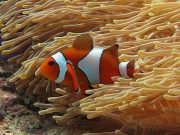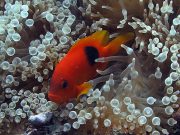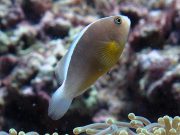Diving with Clownfishes
Lanta Marine Life | Amphiprioninae
Clownfish or anemonefish are the sister family to the damselfishes, and can be spotted easily on Koh Lanta dive trips. With adults reaching 15 cm, this is a family of small fish which display a very unusual partnership with some sea anemones.
Clownfish have developed a mucus coat mutation which allows them to live within the stinging tentacles of sea anemones. The clownfish, or anemonefish are protected from predators which cannot tolerate the stinging tentacles on the anemone. In return the clownfish defend the anemone from parasites and other fish who may prey on them ,such as butterflyfish.
Clownfish mostly feed on small plankton, with a small portion of their diet coming from algae and the undigested food from their host anemone. In return, fecal matter from the clownfish provide nutrients to the host anemone. The constant movement of the clownfish fins helps to provide water circulation and aerate their host anemone tentacles, especially at night when photosynthesis does not occur.
In a group of clownfish living within an anemone, the largest is female, and all others are male. The next largest colony member is the dominant male, breeding with the female 'leader'. All other smaller males actively stall their growth in order to remain subordinate and thus not present a threat to the dominant male (in case they are ejected from the anemone). A clear hierarchy exists, with each subsequent male member of the colony being smaller than the one above it. Some colonies can be 5, 6 or more members. The female will defend the anemone from invasion.
If the female clownfish leaves the colony, or dies for example, the dominant male will undergo a preiod of rapid growth and change sex to replace the previously dominant female colony leader. The next lowest male in the colony hierarchy will then also rapidly increase in size to become the dominant male and create a new breeding pair. This process of rapid and controlled growth is repeated for all juvenile males so that their ranking positions within the colony are preserved.
4 species found on this page:
Clark's Anemonefish
(Amphiprion clarkii)

Amphiprion clarkii @ Koh Haa
The Clarks Anemonefish, or Yellow-tail Anemonefish has a variable body colour, ranging from black to entirely orange. The body colour is determined by the host anemone, There are a pair of wide white or pale bluish bars on the body. The tail fin is yellow, possibly with a white tail fin base, and usually with an abrupt boundary if the body colour is black. The other fins are variably black to yellow-orange. The orange body variation may have a dark blotch behind the second white bar.
Males of this species may grow to 10 cm, and females to 15 cm, but often observed smaller than this. Sex reversal is completed in 5-6 months. Clarks Anemonefish can be found with the anemones Cryptodendrum adhaesivum, Entacmaea quadricolor, Heteractis aurora, Heteractis crispa, Heteractis magnifica, Heteractis malu, Macrodactyla doreensis, Stichodactyla gigantea, Stichodactyla haddoni, and Stichodactyla mertensii.
False Clown Anemonefish
(Amphiprion ocellaris)

Amphiprion ocellaris @ Koh Haa
The False Clown Anemonefish ranges from orange to reddish-brown and has 3 white bars on the body. The middle white bar has a forward projecting bulge. There are variable amounts of black edging on the white bars and the fins. The Northern Australian variation may be black.
The False Clown Anemonefish can be distinguished from the Clown Anemonefish (Amphiprion percula) by amount of black colouring and by location - only the False Clown Anemonefish lives in the Andaman Sea.
This species grows to 11 cm and is associated with the anemones Heteractis magnifica, Stichodactyla gigantea, and Stichodactyla mertensii.
Red Saddleback Anemonefish
(Amphiprion ephippium)

Amphiprion ephippium @ Koh Bida
The Red Saddleback Anemonefish has a red to reddish-orange body. There is a large black blotch on the rear body. The blotch size varies between individuals. Juveniles of this species have a red-orange body and a white head bar, but without black body blotch.
The Red Saddleback Anemonefish grows to 12 cm and is most commonly observed with the tentacles of the Bulb-Tentacle Anemone (Entacmaea quadricolor).
Skunk Anemonefish
(Amphiprion akallopisos)

Amphiprion akallopisos @ Koh Haa
The Skunk Anemonefish has a pinkish orangish body with a white mid-dorsal stripe from the head to the tail. The dorsal fin and tail fins are white. The pectoral fin and belly may be yellowish - orangish in colour.
The Skunk Anemonefish grows to 10 cm, but often observed around 5 cm - 6 cm, and is only seen within the tentacles of anemones.
Diving with Clownfishes around Koh Lanta
Scuba Diving & Snorkel Trips
If you'd love a chance to spot Clownfishes on one of our daily high season diving trips from Koh Lanta then send us an email to info@diveandrelax.com.
Join our high season speedboat dive trips to some of Thailand's best dive sites and enjoy small groups, short journey times, with a focus on great personal service, safety and fun.
Not yet a certified diver? Learn to Scuba Dive on Koh Lanta with the 3 day SSI Open Water Diver course.
Book online to save 10% on dive trips and scuba courses on Koh Lanta.
Find Out More
Indo-Pacific Marine Life Guides
- Allen, G., Steene, R., Humann, P., DeLoach, N. (2003) Reef Fish Identification, Tropical Pacific. Jacksonville, FL., USA: New World Publications, Inc., ISBN 1-878348-36-1.
- Humann, P., DeLoach, N., (2010) Reef Creature Identification, Tropical Pacific. Jacksonville, FL., USA: New World Publications Inc., ISBN 978-1-878348-44-9
- Debelius, H. (2013) Indian Ocean Reef Guide. Frankfurt, Germany: IKAN - Unterwasserarchiv, ISBN 978-3-939767-52-7.
- Debelius, H. (2004) Nudibranchs and Sea Snails, Indo-Pacific Field Guide. Frankfurt, Germany: IKAN - Unterwasserarchiv, ISBN 3-925919-51-1
- Erhardt, H., Knop, D. (2015) Corals Indo-Pacific Field Guide. Frankfurt, Germany: IKAN - Unterwasserarchiv, ISBN 3-925919-69-4.
- Veron J.E.N., Stafford-Smith M.G., Turak E. and DeVantier L.M. (2016). Corals of the World
